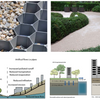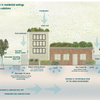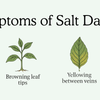Wicking beds and Aquaponics

Posted on: 13 January 2020 by Ian Collins
At WaterUps® we are often asked about aquaponics, both whether aquaponics is similar to wicking bed technology and whether some features of aquaponics can be incorporated into our wicking beds.
While wicking beds and aquaponic systems are both very water efficient plant watering technologies, because they operate in contained growing environments, they are essentially very different:-
- In wicking beds, the plants are grown in soil, while in aquaponic systems they are grown in fish farmed water;
- Aquaponics is more similar to hydroponics, being essentially a combination of hydroponics and aquaculture - the raising of fish and other seafood in tanks.
It is worth looking at the derivation of the term hydroponics to further clarify the differences. The term hydroponics was first used in 1937 to describe the growing plants without soil. Basically, it came from:-
- "hydro" = water, and
- "ponics" = from the Greek "ponos" meaning labour or work
In hydroponics the water does the ‘work’ of carrying /supplying the plant nutrients. The soluble nutrients or chemical fertilizers are added by humans.
Similarly, for aquaponics the derivation is:-
- "aqua" = aquatic, ie. fish and other marine life, and
- "ponics" = work
Therefore, in aquaponics the marine life does the ‘work’ of carrying / supplying plant nutrients.
In wicking beds, it is the (living) soil that does the ‘work’ of carrying /supplying plant nutrients.
History of Aquaponics
It is interesting to note, however, that there is historic evidence of aquaponic systems using soil as a growing medium rather than water. Some of the earliest aquaponic systems have been found in the ‘chinampas’ system of growing crops in shallow lake beds in Mexico that date back many centuries. The Aztec staked out these marshy lake beds with poles and fenced them to keep the mud in and create long thin rectangular beds. The beds were built parallel to each other with canals of water constantly running through them. The fertiliser for these beds was essentially human and fish waste. Like the Aztec, centuries ago native Americans also often planted fish in the soil when preparing the ground, which provided nutrients to the soil as the fish decomposed.
Notwithstanding the above, the use of soil as a growing medium in aquaponics is now very rare. Given that all of my learnings about horticulture, organic farming and permaculture have emphasised the importance of soil microbiology as the key to growing healthy plants, I struggle somewhat with the notion of growing anything without soil.
What is the best growing medium
Looking at the various debates in relation to the merits of aquaponics / hydroponics <‘the ponics’> compared to traditional vegetable growing in soil, it seems that the major positives claimed by ‘the ponics’ are that they save water and that the plants are less disease prone. The main negatives are seen as potentially inferior taste and lower nutrient density. Comparing the ‘ponics’ to growing plants in wicking beds, the main benefits are common to both. On the negative side of the ledger for the ‘ponics’, it is often argued that they are lower in nutrient density and inferior in taste compared to plants grown in soil. Clearly, this is a very broad statement and I have been looking without success for scientific research on this topic. The more I think about it though, the more I realise that the nutrient density of soil grown plants has a direct relationship to the microbiology of the soil itself. Therefore, if you grow food in poor soil then this would be reflected in the quality of the produce. For the ‘ponics’ it would all depend on the chemistry of the water additives.
Brix testing
At WaterUps® we are very interested in the nutrient density of food and have been field testing various plants to see which ones grow best in wicking beds. We have also been looking at various ways of testing the quality of the plants grown in our wicking beds using different soil and compost mixes. We are currently using Brix as one method of testing this. If you have any knowledge of brewing or viticulture you would be well acquainted with the Brix scale. It was originally developed by Adolf Brix in the mid 1800’s to measure the % of dissolved solids, principally sugar, in a solution. Brix measurements are easily taken by using a drop of juice from the plant and placing it on a refractometer. The refractometer measures how the light is bent as it travels through the liquid - the higher the % of soluble solids, the more the light is bent and the higher the Brix rating. The table below, developed by Dr Carey Reams, shows Brix measures for various fruits and vegetables. It provides Brix ratings categorised into Poor, Average, Good and Excellent ratings.

Brix is useful for comparative purposes, but we would suggest caution in using it as a sole test of the nutrient density of food. While best left as the subject for a future blog post, more research is required on the relationship between sugar concentration in plants and overall nutrient density. There are still some questions over the usefulness of Brix in measuring the nutrient density of food. These questions include:-
- Is a higher level of sugar
necessarily a true indication of nutrient density, and - How do you adjust for the water content - ie. a dried out piece of the same plant will have a higher Brix than a fresh one, because it has a lower water content. Maybe for comparison purposes the rule should be, always test at time of harvest.
Fertiliser
The key to the nutrient density of plants is the microbiology of the growing medium. In wicking beds we use compost / organic matter to maintain soil health. In hydroponics, the plants require constant inputs of chemical fertilisers and, in aquaponics, constant inputs to feed the fish.
Soil health can also be improved by the addition of fish emulsion, thereby taking advantage of some of the benefits claimed by aquaponics. With a NPK ratio of 4-1-1, fish emulsion can provide a great nitrogen boost to plants and we recommend using it as a foliar fertiliser.
Incorporating aquaponics into a wicking bed system
I am aware of people that have linked their aquaponic systems into the water reservoir of their wicking beds and they claim to be achieving good results. Their basic argument is that in addition to self watering, the wicking beds become self fertilising. I haven’t tested this so cannot really comment, except to raise the following points:-
- When fertilising our plants with fish emulsions and compost teas, we either foliar fertilise or add the liquid to the soil. We don’t add it to the water reservoir to avoid the build up of sediment;
- We advise against keeping the water reservoir full to encourage aeration.
Soil health rules!








